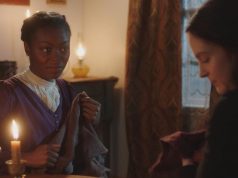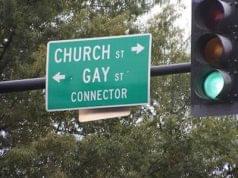Whether or not you believe The Book of Mormon is true — and I should say up front that I do — many of its stories are prime movie material, full of drama, excitement and inspiration. I suspect one day a good film will emerge that makes use of the book’s events and characters.
“The Book of Mormon Movie” is not that film. Produced, written and directed by Gary Rogers, who has no prior film experience, it is obviously the work of someone, well, with no prior film experience. Its screenplay (for which Craig Clyde is co-credited) merely recreates all the events of the first 66 pages of The Book of Mormon without any regard for plotting, storytelling or character development. There is no climax, no clear narrative path. The acting is uniformly bland, as if the actors are merely reciting scripture (which they often are), rather than portraying living, breathing people. The movie is the very definition of “perfunctory,” seemingly made just for the sake of making it. It is about as imaginative as if a committee of dull, suit-wearing middle-aged men got together and tried to stage a ballet.
That Rogers made it with the pure goal of bringing a beloved work of scripture to life, I do not question. But the finished product is pedestrian and mishandled. It is a classic case of a filmmaker’s love for his material being much stronger than his talent for filming it.
For those unfamiliar with the text, here’s the Cliff’s Notes version of what the film covers (which is the books of 1 Nephi and 2 Nephi; Rogers plans another six films to tell the rest). Set in approximately 600 B.C. in Jerusalem, the story is of a prophet named Lehi (Bryce Chamberlain) who is warned by the Lord to take his family and head for the hills, lest they be a) killed by angry townspeople who don’t cotton to Lehi’s denouncement of them as “wicked,” or b) caught up in the impending destruction by outside forces. (This destruction will come because of the aforementioned wickedness, by the way.)
So Lehi takes off with his wife Sariah (Jan Broberg Felt), his daughters, his good sons Nephi (Noah Danby) and Sam (Kirby Heybourne), and bad sons Laman (Mark Gollaher) and Lemuel (Cragun Foulger). The boys get sent back to Jerusalem twice, first to obtain important religious records from the evil, drunken Laban (Michael Flynn), then to fetch Lehi’s buddy Ishmael (Ron Frederickson) and his family, especially his daughters, since wives are needed. Then they build a boat and sail to the New World.
The trouble is that what makes for a good religious document doesn’t necessarily work as a film. For one thing, you need an interesting, dynamic protagonist, and Nephi is not one. He has no apparent character flaws, even slight ones, and he doesn’t change, learn or grow over the course of the film. Since the record is mum on the subject of Nephi’s rough edges, some fictionalization would have been needed to make him work as a movie character. I’m not saying make him a bad guy; I’m saying make him a human being. At the very least, give him an important lesson to learn. The movie version of Nephi is exactly the same at the end as he was at the beginning. And that’s boring.
At the other end of the spectrum, there’s Laman, Nephi’s constantly backsliding brother. Readers of the text have noted that Laman is capable of seeing an angel on one page, and complaining again on the next. (It is also true, though I had not noticed it until seeing it enacted on the silver screen, that Laman’s solution to everything is to tie Nephi up.) When the story is told in broad, general strokes, it seems unlikely that a real person would behave that way; obviously there are details omitted for the sake of brevity that would have explained Laman’s personality and motivations. A movie is a golden opportunity to explore that — not to make him the central character, of course, but at least to make him believable as a villain. But in Rogers’ movie, Laman is as uneven and inscrutable as he is in the text. That’s OK in the book, because you’re not reading the scriptures to see three-dimensional characters. It’s not OK in a movie.
There is no “story” in these 66 pages, at least not the kind of story that has exposition, rising action, climax and resolution. There is, rather, a series of episodes, any of which could conceivably be fleshed-out, given the just-mentioned elements of story, and turned into films. But instead, Rogers has merely propped The Book of Mormon on an easel and filmed every page, whether it’s useful in telling the story of these people or not.
One of the most dramatic events is when Nephi is compelled by the Lord to kill Laban. In the text, Laban has passed out drunk and Nephi must switch clothes with him, fool a guard, and make off with the brass plates. In the film, Nephi puts Laban’s clothes on — notably a large, gaudy breastplate — as soon as Laban is unconscious. He’s not an imminent threat; why does Nephi have to kill him? Reading the scripture, I have no problem with the notion that sometimes God may command a prophet to act contrary to orthodoxy. Seeing it portrayed in the film, though, it reminds me of the insane religious zealots who do heinous things because “God told them to.” It’s uncomfortable.
There’s more discomfort later, when Nephi uses the power of God to shock his rebellious brothers. Again, in the text, it makes sense. On the screen, it seems weird, with Nephi prefacing the punishment with a “this is going to hurt, but it’s for your own good” kind of speech.
The film’s dialogue is an awkward mix of King James-style scripture-talk — often direct quotes from The Book of Mormon — and modern language. People say “thee” and “thou” sometimes, and “I know not” instead of “I don’t know,” but they also say things like “Let’s go” and “You’re always spoiling our fun!”
(I don’t know how the dialogue could have worked, frankly. Writing it all in scripture style would prevent the characters from seeming like real people, and writing it in more modern language would make them seem absurd. So this was going to be an uphill battle from the beginning.)
Sean P. Means, my friend and colleague at the Salt Lake Tribune, laid down the law in his review of “The Singles Ward.” He wrote: “It’s tempting to go easy on ‘The Singles Ward,’ since it’s a local production. But when you must pay the same $7 that gets you into ‘A Beautiful Mind’ or ‘The Lord of the Rings,’ amateur hour is over.”
He is exactly right. “The Book of Mormon Movie” may have honest, even noble, intentions. Its budget was comparatively low, its director/writer inexperienced, its source material difficult to transfer to the cinema without upsetting fans who would prefer that not a word be changed. (You thought Harry Potter enthusiasts were insistent!) But that doesn’t matter. They’re charging the same money to see this as they are to see good movies. It must be held to the same standards, at least artistically.
Whether it is spiritually moving is another issue, and not one that can be examined in a film review. Such matters are extremely personal, after all. (Did it move me? Yes, briefly, during Nephi’s visit with the angel who explained Lehi’s Tree of Life dream.) I can say “The Book of Mormon Movie” is “good” in the sense that it is wholesome and highlights sound principles. I cannot say, however, that it is “good” in the sense of being well-acted, well-written or well-executed.
One final note. After seeing the film, I went to The Book of Mormon to verify some details, and to compare how the movie differed from its source material. In so doing, I got caught up and read a few pages of 1 Nephi, which I hadn’t done in a while. If one of Rogers’ goals is to inspire people to read The Book of Mormon, then I suppose he succeeded. As a religious tract, a literal reenactment of events portrayed in scripture, the film is OK. As a film, something you watch for entertainment, enlightenment or enjoyment, it is not. I hope my readers will understand the difference and see why, for all its good intentions, “The Book of Mormon Movie” is neither a marvelous work nor a wonder.
C- (1 hr., 59 min.; )




